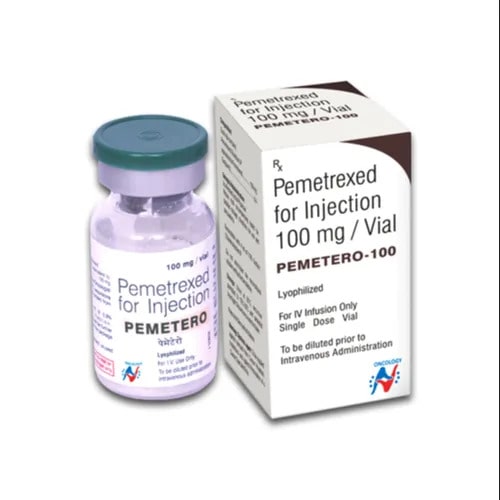Product Introduction:
Pemetero is a cytotoxic antifolate chemotherapy agent used primarily in combination with other drugs for the treatment of advanced or metastatic lung cancers. Its role in first-line, maintenance, and second-line therapy for NSCLC makes it a key drug in modern oncology protocols.
Uses (Indications):
Pemetero (Pemetrexed) is approved for the treatment of:
-
Malignant pleural mesothelioma in combination with cisplatin
-
Non-small cell lung cancer (NSCLC) – non-squamous subtype
-
First-line therapy for advanced NSCLC with cisplatin
-
Maintenance treatment in patients with NSCLC post-initial therapy
-
Second-line monotherapy after prior chemotherapy failure
-
Investigational use in pancreatic, bladder, cervical, and ovarian cancers
Storage Instructions:
-
Store the unreconstituted vial at 2°C to 8°C (36°F to 46°F)
-
Protect from light and moisture
-
After reconstitution, use within 24 hours if stored at 2°C–8°C
-
Keep away from children and dispose of safely after use
-
Do not freeze the diluted solution
How It Works (Mechanism of Action):
Pemetrexed is a multitargeted antifolate that disrupts folate-dependent metabolic processes essential for cell replication. It specifically inhibits:
-
Thymidylate synthase (TS)
-
Dihydrofolate reductase (DHFR)
-
Glycinamide ribonucleotide formyltransferase (GARFT)
These enzymes are critical for purine and pyrimidine synthesis, which are required for DNA and RNA production in rapidly dividing tumor cells. Inhibition leads to cell cycle arrest and apoptosis (programmed cell death) of cancer cells.
Side Effects:
Common Side Effects:
-
Fatigue
-
Nausea and vomiting
-
Anemia, leukopenia, neutropenia
-
Diarrhea or constipation
-
Mucositis (mouth sores)
-
Rash and itching
Serious Side Effects:
-
Myelosuppression – can lead to severe infection or bleeding
-
Kidney dysfunction – elevated creatinine, renal toxicity
-
Liver enzyme elevation
-
Pulmonary toxicity – interstitial pneumonitis
-
Severe cutaneous reactions – including Stevens-Johnson Syndrome
-
Sepsis and febrile neutropenia – potentially life-threatening
Dosage (Typical Recommended Dose):
-
Standard dose: 500 mg/m² administered IV over 10 minutes on Day 1 of a 21-day cycle
-
Dose adjusted based on body surface area (BSA) and patient’s renal function
-
Given in combination with cisplatin or as monotherapy in maintenance/second-line settings
-
Pre-treatment with folic acid and vitamin B12 is required to reduce toxicity
-
Corticosteroids (e.g., dexamethasone) are given to reduce skin rash
Method of Administration:
-
Administered intravenously (IV) over 10 minutes
-
Use a central or peripheral vein, depending on hospital protocol
-
Hydration may be required, especially when given with cisplatin
-
Administer in a certified medical setting under oncology supervision
-
Monitor blood counts and renal function before each cycle
Precautions:
-
Supplement with folic acid and vitamin B12 before starting and during therapy
-
Avoid in patients with severe renal impairment (CrCl <45 mL/min)
-
Monitor CBC, renal and liver function tests regularly
-
Patients should avoid NSAIDs around dosing days due to kidney risk
-
Do not give to pregnant or breastfeeding women
-
Use effective contraception in both men and women during and after treatment
-
Report any signs of infection, bruising, or bleeding
Drug Interactions:
-
NSAIDs and nephrotoxic drugs – may increase renal toxicity
-
Live vaccines – increased risk of infection due to immunosuppression
-
Cisplatin – co-administered, but can enhance toxicity
-
Folic acid and vitamin B12 – necessary, but timing must be correct
-
Use caution with other myelosuppressive agents
Allergies (Warnings for Allergic Reactions):
-
Hypersensitivity reactions may include rash, fever, or dyspnea
-
Anaphylaxis is rare but requires immediate discontinuation and emergency care
-
Premedication with corticosteroids is often given to reduce risk of allergic reactions
Overdose Information:
-
Overdose can result in profound bone marrow suppression
-
Symptoms may include severe anemia, neutropenia, bleeding, mucositis
-
There is no specific antidote – supportive care and transfusion may be needed
-
Dialysis is not effective due to high protein binding
-
Hospitalization may be required for monitoring and intensive support
Missed Dose Instructions:
-
Since this is a clinic-administered injectable drug, missed doses are typically rescheduled by the oncologist
-
Do not attempt to take at home
-
Consult your oncology team immediately if you miss a scheduled infusion
-
Blood counts must be checked before rescheduling
Additional Notes:
-
Pemetrexed therapy requires supportive care to reduce toxicity—supplements, steroids, and hydration
-
It is not effective in squamous cell NSCLC, only non-squamous subtypes
-
Regular monitoring of blood and organ function is critical
-
Response to therapy is evaluated via imaging every 2–3 cycles
-
May be used in combination protocols or as monotherapy based on cancer stage and prior treatment history
-
Patients should report persistent cough, fever, or chest pain—could indicate lung toxicity



